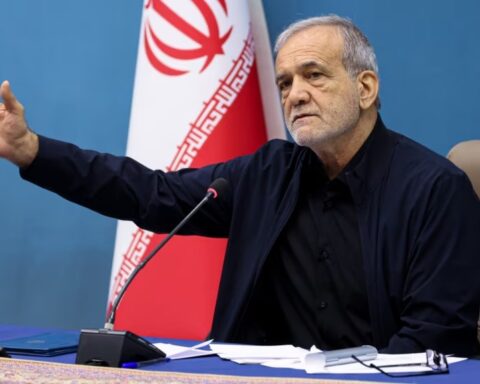At first the debate was about sending tanks to Ukraine; now it’s about planes. Mostly reliant on Soviet-era MiGs, Ukraine has repeatedly asked the West for fighter jets to help defend itself against Russian attacks.
But, so far, both the United States and the United Kingdom have said no, citing concerns about escalating the war and preferring to focus on military support in other areas. Other politicians and experts have said there would be too many training and logistical challenges in gifting Ukraine Western-manufactured aircraft.
RFE/RL’s Georgian Service spoke to Greg Bagwell, a former British Royal Air Force commander and combat pilot and the current president of the Air and Space Power Association, a U.K.-based organization that promotes “discussion and debate on how air power influences today’s world.”
Air Marshal Bagwell spoke about the deficiencies in Russian air power, the reasons why the West is so afraid of sending fighter aircraft, and why the ubiquitous and “very capable” F-16 would be the best option for Ukraine.
It’s fair to say that not much has gone according to plan for the Russians in the war in Ukraine. What are the reasons behind Russia’s failure to establish uncontested air supremacy?
Greg Bagwell: It’s a very good question. You could argue they never necessarily thought they needed it, that they thought this would be over quickly and they would just, through overwhelming military might and speed, they would destabilize the country and effectively take it over without any fuss. So, I think that was the first thing that went wrong. It may be that they never had a plan to do this properly and that [they thought] their belief in their own will was enough, and therefore they didn’t approach this in the right way.
I actually think it’s slightly different to that. [Regarding] Russian [air] capability, based on what they say it can do, you would think that they are a match, or more than a match for Ukraine and potentially more than a match for the West. But actually, that’s never been borne out whenever we’ve lifted the lid. It was very true after the Iron Curtain came down that when you lift the lid, actually, yes, on the surface, the aircraft might have the capabilities, the numbers, if you will. But if you don’t have the logistics support, you don’t have the networks, the data management, the supply chain, the armament interface, the sensors, and perhaps even more importantly, you don’t have the level of training, then your very expensive, very capable machine isn’t able to perform at the highest level of its function.

And I think what we’ve seen, particularly from the Russian Air Force, is that they don’t have the skills to get the full potential from these platforms. Because their training is, as we would call it, rather regimented. It’s very formulaic. They have set processes and procedures. The West doesn’t fight like that; we’re far more fluid, because we have the networks and the sensors, [and] we like to fight a far more fluid battle. And that’s not what Russia is good at. It’s good at military mass and just pushing and overwhelming. And it has proven that in Syria and elsewhere, but I think what’s happened here in Ukraine is that they met someone that is thinking far more cleverly than they are, and they’re not able to defeat [them].
So, I think that is a key part as to why we haven’t seen [much of] Russian air power. There’s probably one other element: They’re probably quite fearful of Ukraine…[of] being shot down in Ukraine, losing one of [their] high-end, rather expensive, and rather modern [pieces of] equipment and compromising the intelligence of all sorts of people…. And therefore, they’re relying on either indiscriminate attacks or long-range missiles that only have a certain effect against fixed targets, which more often than not will tend to be civilian in nature.
Onto the question of Western countries sending fighter jets to Ukraine. What’s the reasoning, the rationale behind not sending them, which seems to be the consensus at this point, in Washington, London, and Berlin?
Bagwell: You’re going to have to ask me to be imaginative here, because I can’t see the reason why not. But I know why it happens…. The primary reason we have not seen aircraft pushed forward to Ukraine is that there is a perception, falsely in my view, that aircraft cross some sort of red line as to what is acceptable to Russia, in order to support Ukraine. And, of course, Russia would [welcome] that impression…because the last thing they need is Western aircraft troubling them over the skies of Ukraine. I think the view is that aircraft can be offensive in nature and clearly strike a lot deeper and therefore [can] go into Russian territory…. Russia, [Russian President Vladimir] Putin will see that as a step too far and will react potentially very disproportionately. And there is a concern that it might drag other nations, NATO or whatever, into the conflict.
For understandable reasons, everyone’s trying to avoid escalating this conflict…. So, I think that’s really the question here. Are we, in gifting aircraft, going to push Russia into a very different response either against Ukraine or potentially against supporting nations? I believe that would not happen. As much as Russia would not like to see modern aircraft on the front line, I don’t think it’s going to push them into doing something irrational. That’s my opinion, other people will have a different opinion.
As much as Russia would not like to see modern aircraft on the front line, I don’t think it’s going to push them into doing something irrational.
I know the stakes are high, so people are going to think through this very carefully. But I think if it’s used in a limited role, particularly for air defense or for the defense of Ukraine, I don’t really see why people can see that as escalatory. It is merely giving the tools to a nation to defend its sovereign borders, in accordance with international law. There’s nothing there that you can pick holes in. I think we saw that a little bit with the tanks. Tanks previously were seen as some sort of red line — that that was a step too far. Well, we’ve busted through that glass ceiling.
Will it be the same story as with the tanks? First, there was foot-dragging over the tanks and then, eventually, the West caved in. Will we see a repeat of that?
Bagwell: I think we may well see a sequence of events that needs to take place in order to apply pressure that then allows the aircraft to be let go. If you remember, we were talking very early on last year about potentially gifting MiG-29 [fighter aircraft] from former Eastern European Soviet-bloc nations [to Ukraine] but, of course, that fell foul because Poland didn’t want to gift them directly and asked America to effectively be the third-party agent and America didn’t want to be seen as the agent. So, there are diplomatic issues in the background here about what can and can’t be gifted.
One of the reasons I’ve pushed for a [fighter] aircraft like the F-16 is that there are multiple nations that can donate the F-16. And it doesn’t have to be America, America will [just] have to give permission. But America doesn’t necessarily have to be involved. And it may be that the calculation of the president of the [United States] is that as long as he’s not the person that literally gifts the aircraft directly, then it might be acceptable, and it may not cross the threshold.

So, I think, unfortunately, we’re going to see a little bit of a diplomatic political dance here to get to a place where everyone can go, “OK, let’s do it.” I hope we’ll get there, because here’s my frustration: It’s not that simple to start learning a new aircraft and all the systems and situations that you need. I happen to think Ukraine will do it far faster than we would normally have done it. And therefore, they can be quick. But the tanks are already going in, or very soon will be going in. If they go in in the spring into the line, they will go in without air support…. So, we are trying to help Ukraine fight this war in phases, without giving them all the tools. And that’s my concern: that by breaking each glass ceiling, one at a time, we’re trying to do combined-arms warfare one step at a time.
The Germans were refusing to send tanks to Ukraine, unless the United States also got involved and sent Abrams tanks. Is it possible that Denmark and the Netherlands — which probably are the countries that you meant when you said the United States green-lighting other countries sending F-16s — could be fearful of being singled out by Russia?
Bagwell: Yes, of course that is the risk. And that’s why I think, whether America likes it or not, it does have a huge responsibility here in being the litmus test of what is done and what isn’t…. I assume that the Abrams tanks were promised in order to break the deadlock on what was happening in Germany, because I think everybody believed that Leopard 2 was the right tank. Because there were more of them. [And] they are a slightly simpler tank than the Abrams, which has got a jet engine in it. It’s nearly as complicated as an F-16. And it is a long way away from home and needs a very long logistics chain to look after it, with a lot of maintenance.
So, the Leopard 2 was the right answer. And maybe [you’ll] just see Abrams sit in a warehouse [and] never come out. But if that was the price of unlocking the Leopard 2, then so be it. So, it may well be that America has to be a physical donor in order to give other nations the confidence. It may be that permission isn’t enough.
I can’t speak for America. [U.S. President] Joe Biden was asked this question just a few days ago and gave a rather quick answer of “No” [to sending fighter jets to Ukraine]. I’m a believer that never tell the enemy what you’re not going to do. Always keep the enemy guessing….

So, I think we’ve been making a few diplomatic mistakes as to how we signpost…but I happen to believe [the planes] will go eventually. My hope is that they go soon enough…. F-16 isn’t the only answer. But I do believe that, all things being equal, because of what [F-16s] can do, because of how many there are, because of where they are, because of the support network that we can provide…and the fact that we can have multiple donors, so no one or two nations would necessarily be singled out, I think that offers a really strong case for why that aircraft is potentially the right answer.
Training and logistical hindrances have been used as an argument against giving Ukraine fighter jets. How long would it take to train Ukrainian personnel on F-16s?
Bagwell: So, if you were a combat pilot already, in other words, if you had already flown the MiG-29 in combat, and let’s be honest, Ukraine right now has some of the most experienced combat pilots in the world by dint of the last year, and I hope many of them are still going strong. But we shouldn’t talk about numbers, nor should they, but I hope there’s enough of them out there still. And somebody of that caliber would be able to transfer on to a new aircraft, in this particular scenario, because let’s be honest, it’s a war of national survival here…within about six to eight weeks.
Now that’s quite [an] aggressive [timeline]. But I think it’s doable. With virtual-reality simulation, with not having to learn every trick in the book and every system, you could do the basics. Maybe I shouldn’t give away the secrets, but airplanes will fly the same. Up, down, left, right is exactly the same. Throttles, go forward, go faster, come back, go slower. Okay, that’s the basics. Using the radar, employing the weapons, locking up targets requires a little bit of finesse. But you won’t be surprised to know that modern aircraft, particularly modern Western aircraft, have got that down to a relatively fine art…. So, it is learnable in a relatively quick time.
Slightly more difficult is the maintainers learning how to make the airplane serviceable, make it work, get the weapons on it. That takes some time.
Actually, that’s not the most difficult bit. Slightly more difficult is the maintainers learning how to make the airplane serviceable, make it work, get the weapons on it. That takes some time. But again, it’s not rocket science…. With virtual reality, even with assisted reality, a maintainer could be sat there with a camera on his head with somebody back in wherever talking him through some of the processes. So, there are lots of different ways that we could make this work…. My personal opinion is I think this has been used as an excuse as to why they can’t be sent because it’s a rather convenient excuse. They’ve been fighting now for a year; they could have done the full [training] course twice over.
So, let’s stop using the reason that there’s not enough time and get to the real truth: which is when are you going to get the courage to do what’s right? Because the training will happen. Ukraine will make it work — if they can learn how to operate three different main battle tanks in a few months, they can learn how to operate an F-16.
How much of a game changer would Western-manufactured fighter jets be for Ukraine? And can Ukraine get by without them?
Bagwell: Ukraine has clearly been an incredible nation in so many different ways and I mean that very, very sincerely– not only the resilience of the entire nation to just keep going but to be able to effectively dull a country of so much greater size, aggression, military might, and hold them at bay. It is unbelievable. In many ways, they’re their own worst enemy, because actually it means we don’t see how desperate the situation is because everyone thinks Ukraine is having great victories and there are times when they have, but actually, they are still under extreme pressure.
And I think that half the problem is trying not to oversell how well Ukraine have done, even though they have done extremely well. They’ve clearly been able to match the Russian Air Force to a large extent on the terms that they can. Yes, some of these longer-range missiles are harder to attack. And yes, some of that is done through surface-to-air systems rather than air-to-air systems. I’d like to believe Ukraine will find a way no matter what. So, it isn’t a deal breaker, but I don’t want to say that because I don’t want people to give the impression that yes, well, they’ll probably be fine. Because I think the risks are too high of them losing if we don’t help them to the maximum extent.
How detrimental could it be for Ukraine if the West refuses to supply fighter jets?
Bagwell: I’m going to deal with that on two levels, the military level, and if you’d like, the higher level, what we’d call the morale component. I think if the West does choose to limit its help, to tanks, no more, we don’t go beyond tanks, tanks are everything, I think that sends a very poor and weak message to Ukraine. It says, “Look, we’ll help you as much as we can, but we’re not going to give you everything.” And that cannot be helpful for Ukraine, in terms of their morale and their belief that we’ve got their back, because we should have their back. I think it will also send a strong message to Russia that actually, there is a red line. And if Putin pushes hard enough, he can force us to modify behavior. And in that way, he wins. Because he maintains Ukraine at a level he thinks he can get away with. So that’s the first issue.
I actually think that by giving them [the planes], I think we do two things. I think we embolden Ukraine…[with] modern aircraft that, I can tell you now, will frighten Russia. They already don’t come into Ukraine [with aircraft] very much as it is. When you’ve got an F-16 up there with an AMRAAM (advanced medium-range air-to-air missile), you’ll be lucky to see any of them. So, it is going to modify Russian behavior in the air undoubtedly.
It’s going to send such a powerful message to Russia that the West is not going to back down.
Now, it won’t stop them firing missiles from hundreds of miles away. It won’t stop S-400 surface-to-air systems engaging from outside Ukrainian soil. But it will change the calculus that we already know [that] Russia is nervous about employing its air power in Ukraine.
So, in one fell swoop, it’s going to change that calculus. And it’s going to send such a powerful message to Russia that the West is not going to back down. It is not going to limit Ukraine; it is about Ukraine winning and not not losing. And if you want to keep doing this, you are going to come up against the full might of Western industry and equipment, and we have a lot more than you do. And if that’s the way you want to go, then you (Putin’s Russia) will lose. And the longer this goes on like that, and you do lose, you will be so weak that [firstly] you won’t be able to stay in power. And secondly, you will not be able to carry on the way you threaten and the way you currently run and try to manage your international politics. And that would be a victory for everybody…. I think they don’t even have to fly to achieve those effects. I think just the very act of gifting [aircraft], I think you’d see dancing in the streets and rightly so.
Now, in terms of the military impact, an F-16 is still a very capable platform: It has a good radar, it can fly well above the majority of the Russian sound systems in the area apart from the very, very specialized ones. It has a weapons system tied to that radar that can engage the vast majority of Russian aircraft long before they can attack it. The F-16 doesn’t have quite the same stealth characteristics of something like an F-35 and an F-22. But I’ve fought against the F-16. I’ve had the odd trip in one, but I’ve also fought against it. It’s tiny, it’s hard to see on radar, it’s even harder to see in the air with the naked eye. The F-16 is not called a viper for no reason. It’s a vicious, nasty, dangerous little airplane.
If I was a Russian pilot with 100 hours training in an aircraft that I’m a little bit nervous about whether my weapons really work because I’ve never been allowed to use them in training or in wartime, I am going to be shit scared of getting airborne and wondering whether there’s an F-16 up there.
And it’s going to change the way they approach [the war]. If we can take Russian air power and limit its influence on the battlefield and over Ukraine in general, that gives Ukraine breathing space, that’s then going to allow the combined arms effect of the artillery, the HIMARS (High-Mobility Artillery Rocket Systems), the tanks, and everything else to operate as well as it already has done. And this time do it without any concern about what’s above. The combination of those two things will be hugely powerful and ultimately will make most Russians realize that they can’t win….
I think if Putin is not careful, and that he needs to think long term about this, what he’s going to end up showing to all his allies — not that he’s got many these days — is that the Russian equipment is no good. That actually, when it comes down to it, Western air power in particular and Western ground power as well, with the tanks, is ultimately way, way better than the Russian kit. And that’s going to send powerful messages to his allies about what they should be buying or what they can trust. And it’s going to send ripples through an army and an air force that suddenly no longer has confidence in its equipment. So, this has huge impact well beyond just the air-to-air tactical fight.

















